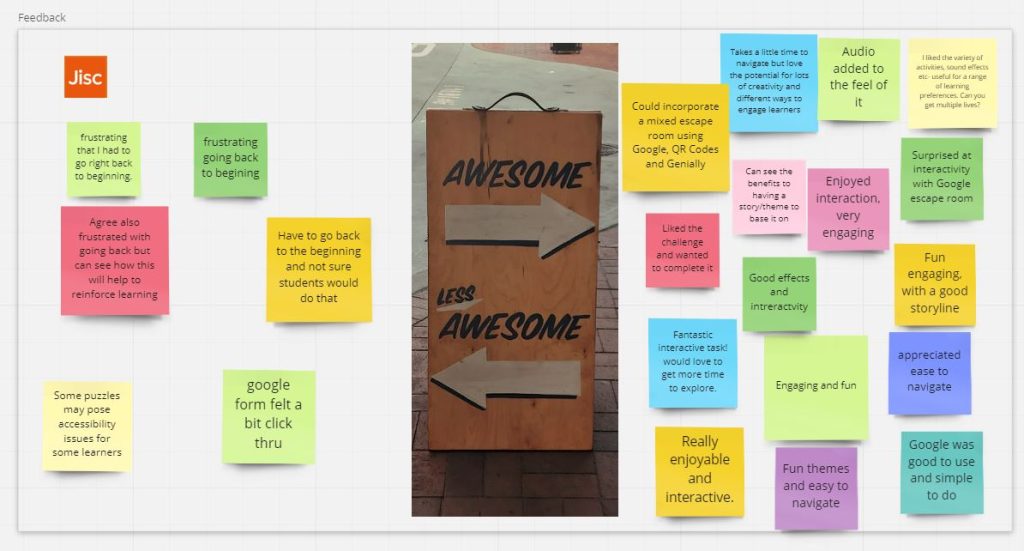This week Jisc ran the Exploring virtual escape rooms in education event for our FE members. We had a lot of fun at the event sharing experiences of how escape rooms can be used to support learning, but I’d like to say a special thank you to Natalie Hopkins from Coleg Gwent for proposing the event.

For the Star Wars fans amongst you, I’m sure you’ll recognise Princess Leia above, albeit a Lego version of her. But what does a reference to the classic 1970s space opera have in common with escape rooms?
Craft a compelling narrative
In the movie, Princess Leia was imprisoned in the Death Star, which prompted an escape involving Luke Skywalker and co. The movie was a huge success and prompted many sequels, prequels and spin-offs, due in no small part to the wonderful storytelling of the original.
It’s the same when creating your own escape room. The story behind all the puzzles and challenges needs to draw you in.
Consider your topic area and ask:-
- Is there an engaging scenario that will resonate with the students?
- How can you make the students feel part of the story?
- How can you create a branching narrative that provides meaningful choices?
If the story isn’t compelling, you’re just cobbling together a series of quizzes and puzzles and missing the point.
Platforms
According to Makri et al (2021)¹, who carried out a review of how escape rooms are being used in education, there are many platforms available to you. Popular choices for escape rooms include sites like Google Forms, because they include options like response validation. Genially is also a good site to explore as it includes a number of templates that help design an escape room with great visuals. However, it’s possible to use any digital platform that you can create puzzles in, but you might like to consider:-
- What is already available within your institution? Are there ‘quick wins’ by having students upskill using existing institutional platforms?
- How do you want the students to complete the escape room? If they are doing it during class time you might want to use a platform like Zoom or Teams that allows you to put students into breakout rooms to complete the puzzles in small groups. If they are trying to do the escape room asynchronously in their own time, then something like Google Forms or Genially might be a better option.
- Do you want to use more than one platform? If so, consider the digital skills of your audience. Creating an escape room that is too sophisticated and difficult to complete is likely to increase drop-out rates.
- Can you create a range of puzzle types in the platform to make the escape room engaging? If you are just going to include multiple choice type questions then students are likely to tire of the exercise.
Benefits and challenges
We provided a variety of virtual escape rooms for attendees to experience. Delegates were also encouraged to share their own. Many people hadn’t done one before. We wanted a range of examples. That way delegates could appreciate that there are many ways of doing escape rooms.
Delegates shared their feedback using a Miro board (see below):

We asked delegates to post a challenge and a benefit of escape rooms. It’s important to approach any new learning activity with a critical eye and not get too carried away by the tech.
Benefits
- The majority, as evidenced from the stickies above, found escape rooms to be very motivating and fun. This is echoed in the research by Vergne who also received positive feedback from students.²
- Escape rooms work best when students complete them in small teams (see Makri’s article below). This helps students to develop team-building skills, besides the explicit learning included in the puzzles.
- Rich digital media included within the escape room (audio, video, images, etc) can help to bring the story alive. This makes the experience more engaging.
Challenges
- Consider how you might help students who may struggle with the activity. Can you incorporate clues if needed? Is there an option to email the tutor for help? Can you minimise barriers faced by individuals by promoting a team-based approach?
- The puzzles need to match the game room theme or story and be understood by the players based on the information available within the room.
- Not everyone enjoys games to the same degree, especially if certain features present accessibility issues. Ask your students for feedback and be prepared to refine your escape room. If you have specific accessibility concerns you might like to join Jisc’s accessibility community of practice and seek help from our experts.
Further resources
Find out more about virtual escape rooms from our collection of useful links on Wakelet. The Wakelet board includes how-tos, research and use cases from the wider community.
We also run Digital Storytelling workshops which will help you to craft a more meaningful story for your escape room.
References
1. Makri, A.; Vlachopoulos, D.; Martina, R.A. Digital Escape Rooms as Innovative Pedagogical Tools in Education: A Systematic Literature Review. Sustainability 2021, 13, 4587. https://doi.org/10.3390/ su13084587
2. Matthew J. Vergne, J. Dominic Smith, and Ryan S. Bowen. Escape the (Remote) Classroom: An Online Escape Room for Remote Learning. Journal of Chemical Education 2020 97 (9), 2845-2848 DOI: 10.1021/acs.jchemed.0c00449

